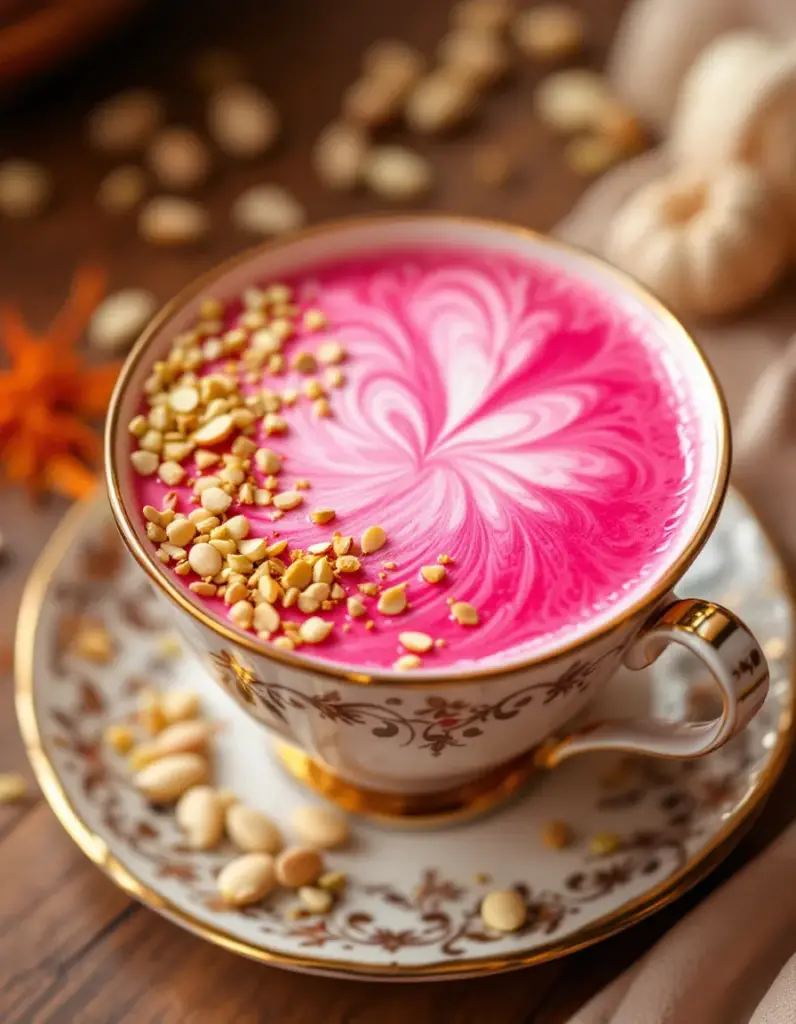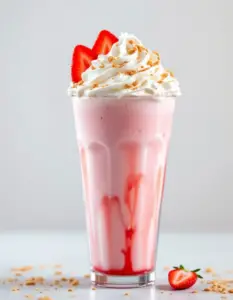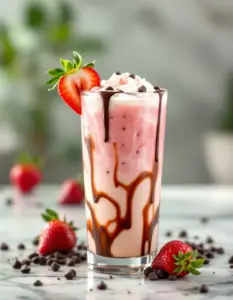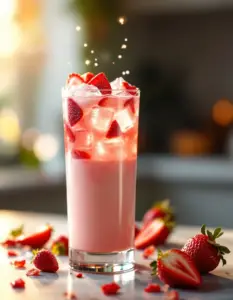How to Make Kashmiri Pink Chai at Home – Easy Recipe!
Kashmiri Pink Chai, also known as Noon Chai, is a delightful beverage that has gained popularity beyond its origin in the stunning landscapes of Kashmir. The mesmerizing light pink hue, achieved through a unique preparation process, captivates the eyes just as much as it enchants the palate. This fragrant tea, infused with spices and the creamy richness of milk, creates a comforting drink perfect for sharing during cold evenings or at festive gatherings.
Making Kashmiri Pink Chai at home is simpler than many believe. With a few ingredients and some technique, you can replicate the restaurant-quality pink chai right in your kitchen. This recipe not only guides you through the step-by-step process but also fills your home with the warmth of spices like cardamom and cinnamon. Enjoy the art of rolling the tea leaves to unleash the full spectrum of flavors and discover why this drink has become beloved universally.
Quick Recipe Highlights
- Flavor Profile: The Kashmiri Pink Chai features a harmonious blend of sweet and savory flavors, highlighted by the subtle tang of salt and creamy richness from the milk.
- Texture: This chai has a silky-smooth texture that makes every sip feel luxurious, complemented by the frothy foams created during whisking.
- Aroma: The warming aromas of cardamom and cinnamon infuse the air, creating an inviting environment that enhances the chai-drinking experience.
- Visual Appeal: The striking pink hue of the chai is mesmerizing, offering a feast for the eyes that complements its delicious taste.
- Skill Level Needed: This recipe is beginner-friendly, featuring easy-to-follow steps that anyone can master.
- Special Equipment: Having a traditional samovar is helpful, but a simple saucepan and whisk will suffice.
Recipe Overview
- Difficulty Level: This easy recipe requires basic cooking skills and patience to develop the unique flavors, making it accessible for anyone to try.
- Category: Kashmiri Pink Chai is a beverage, serving as a comforting drink that can be enjoyed at breakfast or as an afternoon treat.
- Cuisine: This chai belongs to Kashmiri cuisine, which is known for its rich flavors and aromatic spices, showcasing a blend of Persian influences.
- Cost: The approximate cost for making this chai is low, primarily involving pantry staples like tea leaves, milk, and spices.
- Season: Perfect for chilly weather, Kashmiri Pink Chai can be enjoyed any time of year but is especially comforting in winter.
- Occasion: This beverage is ideal for special gatherings, festive occasions, or as a unique treat during regular tea time.
Why You’ll Love This Recipe
Kashmiri Pink Chai stands out not only for its striking appearance but also for its incredible taste and texture. The combination of rich, creamy milk and the nutty, robust flavor of green tea creates a delightful contrast that keeps you coming back for more. With the addition of spices like cardamom and cinnamon, every sip is a warm embrace that soothes the soul. This beverage goes beyond just a drink; it provides a comforting experience that delights your senses and provides a moment of respite from the day.
Preparing Kashmiri Pink Chai at home is a rewarding experience. The method draws you into the calming ritual of making tea, allowing you to engage your senses fully. Boiling the tea leaves, whisking the mixture to bring out the frothy texture, and savoring the aroma as it brews turns the process into a culinary meditation. This ritual can transform ordinary moments into cherished ones, encouraging the tradition of family and friends sitting together over cups of warm chai.
Nutritionally, Kashmiri Pink Chai offers a unique blend of benefits. The tea provides antioxidants that contribute to overall health, while the milk adds calcium and protein, making it a wholesome choice. Pair your chai with some light snacks, and you have a balanced treat that not only satisfies your cravings but also nourishes your body in moderation.
When hosting gatherings, Kashmiri Pink Chai serves as a conversation starter. Its unique color and flavor profile intrigue guests, inviting them to try something new and celebrate the culture it represents. Sharing this chai becomes a gesture of hospitality, bridging gaps between diverse backgrounds while introducing flavors rooted in Kashmiri traditions.
Lastly, this chai is accessible to a broad audience. The ingredients are typically easy to find, making it a great option for anyone looking to try a new recipe without the hassle of sourcing exotic components. You can easily keep the kitchen stocked with what you need to whip up a comforting cup of Kashmiri Pink Chai whenever the craving strikes.
Historical Background and Cultural Significance
Kashmiri Pink Chai, or Noon Chai, traces its origins to the enchanting region of Kashmir, where it has been a staple for centuries. Traditionally served at celebrations, weddings, and during cold winters, this chai not only provides comfort but also symbolizes the heritage and hospitality of the Kashmiri people. Rooted in Persian influences, it reflects the region’s rich cultural tapestry.
The cultural significance of this tea cannot be overstated. Imbued with warmth and character, it has played a central role in Kashmiri hospitality, often being served to guests as a show of respect and generosity. Additionally, Noon Chai is deeply intertwined with societal rituals, often accompanying traditional meals during gatherings and special occasions.
As the years progressed, Kashmiri Pink Chai has evolved from a customary drink to a trendy beverage found in cafes worldwide. While many modern variations have emerged, the core ingredients and preparation methods remain closely aligned with the original tradition. This evolution has allowed the beverage to reach an ever-growing audience while preserving its deep-rooted cultural significance.
Interestingly, regional variations of Noon Chai exist, showcasing how different families and communities interpret this cultural treasure. Whether adapted with unique spices or served with different types of milk, these variations tell stories of the families that steep them and the robust history that Kashmiri Pink Chai embodies.
Ingredient Deep Dive
- Green Tea Leaves: Essential for creating the signature flavor of Kashmiri Pink Chai, the green tea is traditionally used for its robust character and health benefits. When selecting tea, look for high-quality, whole leaves for the best flavor extraction. Proper storage in a cool, dark place will keep the leaves fresh, while alternatives such as black tea can be used for a different flavor profile.
- Milk: Typically whole milk is used, contributing to the creamy texture. The choice of milk can vary with preferences for dairy or non-dairy alternatives. High-fat milk enhances the richness of the chai, while lower fat options may alter the overall taste. Consider full-fat dairy for optimal results, and store any leftovers in the refrigerator to maintain freshness.
- Cardamom: This spice adds warmth and depth to the chai. It is essential for flavoring and can also offer numerous health benefits. Freshly cracked cardamom pods will provide the best flavor. Store any unused pods in an airtight container, and consider substitutions such as cinnamon or nutmeg for different flavor profiles.
- Salt: A unique addition in Kashmiri Pink Chai, salt balances the sweetness and enriches the overall taste. It’s best to use a fine-quality sea salt for optimal flavor. When adding salt, do so gradually, adjusting to personal taste preferences.
Common Mistakes to Avoid
- Not using freshly cracked cardamom: To achieve an authentic flavor, always use freshly cracked cardamom pods rather than pre-ground spices.
- Skipping the whisking step: Whisking the chai is crucial to releasing its signature foamy texture and ensuring the flavors blend properly.
- Using low-fat milk: Whole fat milk yields the creamy consistency characteristic of Kashmir Pink Chai, so avoid low-fat variants unless needed.
- Boiling the tea for too long: Over boiling can create a bitter taste in the tea, so be attentive to the brewing time.
- Neglecting the salt: The salt is an essential ingredient in Kashmiri Pink Chai, enhancing the overall flavor; don’t omit it.
- Not letting the tea steep enough: Allow the tea to brew properly to develop the full flavor profile; 10-15 minutes is ideal.
- Rushing the process: The preparation of this chai is an art that requires time and patience for best results.
- Forgetting to strain: Ensure to strain the chai well before serving to eliminate any undissolved particles.
Essential Techniques
To successfully create Kashmiri Pink Chai, the whisking technique is vital. This step incorporates air, resulting in the frothy texture characteristic of the beverage. To master this technique, use a traditional whisk or a hand-held mixer until your chai has a light and airy consistency. Common pitfalls include not whisking enough or doing it too roughly, which can create bubbles but not the velvety texture desired. Visual cues of success include a luminous pink hue and an airy froth topping.
Another essential technique is the proper brewing of the tea leaves. This is where you allow the flavors to steep and develop complexity. Master this technique by paying attention to time and temperature; have the water boiling before you introduce the tea. A common mistake is to rush this step, which results in a lackluster flavor. Look for a rich, bold scent and a rosy color as indicators that your tea has brewed adequately.
Pro Tips for Perfect Kashmiri Pink Chai
1. Start with high-quality loose leaf green tea to enhance the flavors and aroma of the chai.
2. Create a lush color and texture by whisking vigorously to ensure proper incorporation of air.
3. Don’t skip the resting period after boiling; letting the chai rest will enhance its flavors.
4. Experiment with spices; feel free to add star anise or cloves for a personal touch.
5. Adjust the salt content according to taste, balancing the sweetness and creaminess.
6. For an extra decadent version, try splashing a bit of evaporated milk for richness.
7. Serve with traditional accompaniments like sweet pastries or cookies for an authentic experience.
8. For a festive touch, consider garnishing with crushed pistachios for visual appeal and added texture.
Variations and Adaptations
Explore regional variations of Kashmiri Pink Chai by adjusting the spices based on local preferences. For instance, adding rose water can enhance floral notes, creating a lighter beverage perfect for summer occasions. Seasonal adaptations might include infusing autumnal flavors like nutmeg and ginger to warm the body during colder months.
When it comes to dietary modifications, those avoiding dairy can substitute regular milk with almond or soy milk, creating a delightful vegan version of this classic drink. For a unique twist, introduce flavor variations by incorporating sweeteners like honey or flavored syrups to customize your chai experience further.
Texture modifications can also be applied by blending the chai for a creamier finish or leaving it chunky for a more rustic feel. Presentation alternatives include serving it in colorful glasses or traditional Kashmiri cups, enhancing the overall experience with visual interest.
Serving and Presentation Guide
Plating techniques for Kashmiri Pink Chai can enhance guest experience. Consider using traditional Kashmiri cups for authenticity, or elegant glasses for a modern touch. Garnish the chai with crushed almonds or pistachios, adding visual and crunch elements.
Accompanying snacks can further elevate the experience; serve with sweet breads or light pastries that complement the chai’s rich flavor. Temperature is crucial—serve hot to maximize the chai’s soothing properties; it should be steaming but not scalding.
Portion control is another aspect to consider: traditionally, chai is served in small cups to encourage sipping and sociability. This method fosters conversation and allows guests to have multiple servings without excessive indulgence.
Wine and Beverage Pairing
While wine isn’t the typical accompaniment for Kashmiri Pink Chai, certain non-alcoholic beverages pair seamlessly. A light soda or sparkling water infused with lemon can cleanse the palate between sips. If you’re looking for a tea pairing, consider serving curry-flavored teas that complement the spices within the chai.
For unique pairings, a smooth, creamy latte could enhance the chai’s profile without overwhelming it. Avoid overly sweet or heavy beverages, which can overshadow the elegant flavors of the chai. Aim for refreshing options that don’t compete but rather harmonize with the warm, inviting chai.
Temperature considerations are also essential when serving—you want to ensure that guests enjoy their chai at the desired warmth. Presenting it in heat-retaining mugs can help maintain its temperature throughout your gathering.
Storage and Shelf Life
When it comes to storing Kashmiri Pink Chai, it’s best enjoyed fresh, but if you have leftovers, store them in an airtight container in the refrigerator for up to three days. Reheating can bring back the chai’s cozy charm; gently warm it on the stove while whisking to restore some of its delicious texture.
For optimal flavor, avoid freezing as it can alter the texture and taste. If reheating, aim for a low and slow method; high heat can scorch the chai. Pay attention to visual signs of spoilage, such as changes in color or the presence of sediment, indicating that it’s best to discard.
As with any tea, it’s crucial to keep the storage container clean and free from other strong odors, preserving the chai’s delicate flavors. Consuming within a few days is advisable for maintaining freshness and taste.
Make Ahead Strategies
To prepare ahead for a gathering, you can follow a few simple strategies. Brew the tea and store it separately from the milk; this will keep the flavors intact until serving time. If desired, whisk the chai and store it in an insulated container to maintain warmth.
Consider preparing the spice mix in advance, allowing them to infuse overnight, enhancing the flavor when added during the final brew. Chilling the milk beforehand can also save time on the day of your event, enabling a quick reheat.
Be sure to plan your serving timeline accordingly; ideally, reheat the chai just before serving to ensure guests enjoy it at its best. Fresh ingredients like nuts can be added just before serving for added crunch and flavor.
Scaling Instructions
If you need to scale the Kashmiri Pink Chai recipe, adjust the quantities of your ingredients while keeping the proportions consistent. Halving the recipe is straightforward, and you can use half of the specified amounts.
When doubling or tripling, consider the equipment size: ensure you have a large enough pot to accommodate the increased volume without overflowing. Timing may need adjusting when increasing the batch size; larger quantities take longer to brew effectively.
For storage considerations, be mindful that larger amounts may require multiple containers. When scaling, keep the cooking method and timings in mind to ensure the same quality is maintained across all servings.
Nutritional Deep Dive
Kashmiri Pink Chai provides a well-rounded macro breakdown, primarily consisting of carbohydrates from the milk and sugars added, minor protein from the dairy, and healthy fats if whole milk is used. The antioxidants present in green tea contribute to overall well-being, promoting improved metabolism.
Micronutrient analysis indicates that this chai offers calcium and vitamins from milk, while spices like cardamom provide essential oils known for their anti-inflammatory properties. Drinking this chai in moderation can aid digestion and improve heart health.
For dietary considerations, be aware that portion sizes matter; the creamy depth of chai can lead to calorie accumulation. Consider offering smaller servings alongside mindful snacks to enhance both enjoyment and nutritional balance while keeping a keen eye on sweetness levels if managing sugar intake.
Dietary Adaptations
Kashmiri Pink Chai can be easily adapted to fit various dietary needs. For gluten-free options, the recipe is naturally gluten-free; simply ensure any accompanying treats are also gluten-free.
To create a dairy-free version, substitute regular milk with almond, soy, or oat milk. This not only accommodates lactose intolerance but also introduces unique flavor profiles to the chai itself.
Vegan adaptations are straightforward, allowing all components to come from plant sources. Low-carb variations can focus on reducing the sugar content or using low-calorie sweeteners that maintain the chai’s essence while fitting within dietary restrictions.
For those on the keto or paleo diets, consider preparing a nut-based milk and ensuring the sweeteners align with dietary goals. Making these adaptations doesn’t compromise the beloved traits of this traditional drink but rather expands its reach.
Troubleshooting Guide
If you encounter a grainy texture, ensure you’ve strained the chai well to eliminate undissolved particles. This is critical for achieving that silky smooth mouthfeel.
For flavor balance issues, consider adjusting the spice levels; adding more cardamom or salt can enhance the chai’s profile if it comes off too sweet or bland. It’s often beneficial to taste as you go along.
Temperature problems can affect enjoyment—if your chai cools too quickly, serving it in insulated mugs can help maintain warmth. To resolve issues with the tea being too bitter, ensure you’re not over-brewing the leaves and avoid boiling the mixture too rapidly.
If using plant-based milks, be aware that some may curdle when heated too harshly. Opt for gentle reheating methods and add the milk slowly to prevent curdling.
Recipe Success Stories
Community feedback on making Kashmiri Pink Chai is overwhelmingly positive, with many praising its ability to bring families together. Readers often share their personal variations, highlighting regional spices or ingredients that showcase their unique heritage while honoring tradition.
Many readers have observed success by tweaking the brewing times or altering the milk types to suit their tastes. Adaptation stories reflect the inclusive nature of this recipe, making it versatile in various cultural contexts.
Suggestions from readers often include pairing chai with specific sweets or biscuits, enhancing the experience with complementary flavors that resonate well with the rich chai.
Photography tips arise often as this stunning chai tends to be a favorite subject for social media shares, encouraging others to appreciate its visual appeal as much as its delicious taste.
Frequently Asked Questions
What makes Kashmiri Pink Chai different from regular chai? Kashmiri Pink Chai utilizes green tea and incorporates milk to create a creamy texture enhanced with salt and spices, resulting in its unique flavor profile and iconic pink hue.
Can I make this chai without a whisk? While a whisk helps achieve the desired frothy texture, you can use a blender to create a similar effect. Just ensure not to make the mixture too airy.
Is Kashmiri Pink Chai caffeine-free? Since it uses green tea leaves, it does contain caffeine, but it’s lower than black tea. Decaffeinated versions of green tea can be used for a caffeine-free option.
How long can I store leftover chai? Store leftover Kashmiri Pink Chai in the refrigerator for up to three days. For best results, consume it fresh.
What are traditional snacks to serve with Kashmiri Pink Chai? Traditional snacks include sweet breads, pastries, or dry fruits. These complement the chai’s rich flavors beautifully.
Can I use condensed milk in my chai? Yes, using condensed milk adds sweetness and richness. Adjust the sugar levels accordingly if you opt for condensed milk.
How do I achieve the perfect pink color? The key to achieving the signature pink is whisking the tea properly during preparation and allowing it to oxidize. Ensure good air incorporation.
Is it possible to make a large batch? Absolutely! Just scale up the ingredients while keeping the proportions consistent and use a larger pot to brew.
Can I use flavored teas? Yes, variations can include using flavored green teas, but traditional recipes extra emphasize the unique flavors of plain green tea.
How do I avoid bitterness in my Kashmir Pink Chai? Avoid boiling the tea for too long and monitor the steeping time closely to keep the flavors balanced and pleasant.
Additional Resources
If you’re keen to explore more recipes, check out our collection of traditional beverage recipes inspired by the vibrant cultures around the world. Dive into ingredient guides that elaborate on unique spices commonly used in Eastern cuisine.
Explore further into chai techniques, including different brewing methods or alternative flavor combinations for a unique twist on your favorite drinks. You can also find equipment recommendations for making the perfect brewed beverages at home.
Keep an eye out for seasonal variations, ensuring your chai recipe evolves with the changing seasons, offering health benefits and culinary excitement throughout the year.
Join the Conversation
We invite you to share your experiences and adaptations when making Kashmiri Pink Chai. Consider posting your success stories or variations on social media platforms, sparking joy and creativity among fellow chai enthusiasts.
Engage with our community by sharing photographs of your chai creations and tips for perfecting the traditional recipe. Your contributions can inspire others and create a collective appreciation for this stunning beverage.
Feedback on your experiences is invaluable. We encourage you to leave your thoughts or suggestions in the comments, fostering a strong community around the rich traditions and modern adaptations of Kashmiri Pink Chai.
The Recipe
Kashmiri Pink Chai
Serves: 4 servings
Prep Time: 10 mins
Cook Time: 20 mins
Total Time: 30 mins
Kitchen Equipment Needed
- Medium-sized saucepan
- Whisk (or traditional wooden whisk)
- Strainer
- Measuring cups and spoons
Ingredients
- 2 cups water
- 2 tablespoons green tea leaves
- 1/4 teaspoon salt
- 2 cups whole milk
- 2-3 green cardamom pods, crushed
- Sugar to taste (optional)
Directions
- In a medium-sized saucepan, bring water to a boil.
- Add green tea leaves and crushed cardamom, then simmer for about 10 minutes.
- Whisk vigorously to aerate the mixture, enabling the color to change to a pink hue.
- Add the milk and salt, and whisk again. Simmer for another 5-10 minutes.
- Remove from heat and strain into serving cups.
- Add sugar to taste, if desired, and serve hot garnished with nuts.
Recipe Notes
- For an extra twist, try adding a splash of rose water.
- Adjust the sweetness level according to your preference; less sugar enhances the chai’s authenticity.
- Feel free to experiment with different spices to find your perfect blend.










